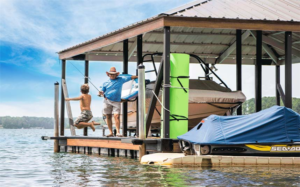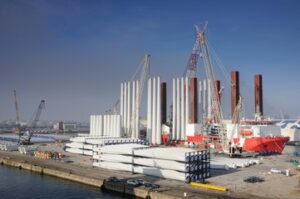A dock can add value to your home and make it easier for you to enjoy water sports or fishing. Before you start building, though, there are several considerations to keep in mind. For more information, click the link https://lakewyliedockconstruction.com/ provided to proceed.
First, it’s important to select a location that minimizes impact on aquatic ecosystems and wildlife habitats. This can involve working with an environmental regulator.

The design of a dock is dependent on many factors. For example, you’ll want to choose a spot on your property that is easily accessible and safe for boating and fishing. Also, you’ll need to make sure that the water depth is suitable for your boat. You should also check with your local government for any restrictions or required permits. Finally, it’s important to be aware of the weather patterns in your area so that you can plan accordingly.
In addition to ensuring that your dock is safe, you’ll also want it to be aesthetically pleasing. You can achieve this by choosing the right materials. For instance, composite materials are resistant to rot and insects. They are also much stronger than natural wood and can withstand the harsh Florida sun. Additionally, they come in a variety of colors and textures so that you can match your home and create a cohesive look.
Another option is to use a jetty-style dock. These are built by submerging strong wooden frames in the water and filling them with boulders and rocks for strength. They’re durable and can handle large water vessels, but they’re expensive to build and maintain. They also disrupt the environment by altering water flow and habitats for marine life.
Lastly, you can use a floating dock made from buoyant plastic materials. These are affordable, flexible, and portable. However, they’re not as durable as other types of docks and can be affected by wind and waves.
Docks can be constructed from a wide range of materials, including wood, steel, and concrete. The type you choose will depend on your needs and budget. For example, a wood dock will require regular maintenance and may need to be replaced in 30 years or so. A steel or concrete dock, on the other hand, will last much longer and can withstand the elements. In addition, it’s important to choose a high-quality material that adheres to industry standards. These standards ensure that your dock is safe, durable, and long-lasting. In particular, it’s important to choose a quality wood treatment.
Materials
Before you can begin building a dock, you must first prepare the area. Make sure to clear all areas around the dock of debris, vegetation, and any other hazards that could cause injuries or damage the structure. It is also important to have a plan of how the dock will be used so that safety measures can be taken into account. This includes incorporating deflective edges and ramps that are suitable for persons with disabilities. In addition, the dock should be easily accessible and made with a non-slip surface to prevent accidents and injuries.
Choosing the right materials for your dock construction is crucial to ensuring its longevity. The type of material you choose will depend on a number of factors, such as the location of the dock, its environmental conditions, and its purpose. For example, if your dock is located in a body of water that is regularly subjected to flooding and high tides, you will want to use materials that can withstand these conditions. You will also need to consider whether your dock will be used by boaters, swimmers, or both.
Wood is a popular choice for the structure of floating docks due to its natural appearance and cost-effectiveness. However, it is essential that you choose a wood with rot-resistant properties and is treated to resist the effects of saltwater submersion. Cedar is an excellent option for these conditions as it has natural oils that are resistant to rot and other forms of water damage. Alternatively, you can also choose to use pressure-treated wood for the frame of your dock. This is a cost-effective option that provides resistance to rot and insects.
Another great alternative to wood is HDPE lumber, which is manufactured from plastic and contains UV inhibitors to resist fading. It is also easy to work with, and it can be cut, routered, and drilled like traditional wood. In addition, HDPE does not rot or leach chemicals into the environment and is highly resistant to mold and mildew.
Other durable options for docks include concrete and fiberglass. These materials offer superior strength and are less affected by boating traffic than wooden docks. When installing a concrete or fiberglass dock, you will need to use a special marine-grade epoxy. You will also need to use hardware that is made of stainless steel or galvanized steel, as these will not corrode in the marine environment.
Installation
While the idea of building your own dock is an exciting one, it is also a massive undertaking that requires careful preparation and installation. If you’re not comfortable working on a project like this, you may want to consider hiring professional dock construction services. These professionals can visit your property, evaluate what is a good fit and create an estimate for you to review. When evaluating these estimates, be sure to take into account any hidden fees or charges that can add up quickly.
Before beginning the construction process, it is important to determine what you want your dock to look like. This will directly affect the design, materials and accessories that will be used. Knowing the purpose of your dock will also help you choose a location and meet any permit requirements.
Once you’ve decided on a location, begin preparing the site by digging footers and setting outer posts. Then, you can start constructing the dock frame to your specifications. Once the basic frame is in place, you can install the decking material, which will be atop the platform and connect to the frame with lag bolts. You can also install shoreline support posts at this time, if necessary.
One mistake many DIY dock builders make is focusing too much on efficiency, which can lead to sloppy and less professional results. For example, it is common for dock builders to skip the step of marking lines on boards where they will drive screws or nails. This step seems simple, but it ensures that all fasteners are driven a consistent distance from the edges and ends of the boards. This will ensure that all parts of the dock are structurally sound and secure.
Finally, it is important to anchor your dock to prevent it from moving or drifting in windy or wavy conditions. You can use concrete anchors or steel chains, depending on your preferences. If you opt for the latter, it is important to crisscross them so that each chain is adjacent to the corner of the dock it is attached to.
Maintenance
As with all construction projects, there are certain steps that must be taken before and after your dock is built. This includes proper preparation and maintenance. The latter includes sanding and staining your dock regularly, as well as checking for signs of wear and tear on the load-bearing areas of the deck assembly. Look for sagging, loose planks, fungal growth, and other conditions that can damage the dock.
In dock maintenance, it is often necessary to replace a section of the structure. This can be done when a portion of the dock is too damaged to safely support the loads it is intended to carry. For instance, a dock may be experiencing excessive rusting or rot, which is not only unsightly but can lead to structural failure that compromises the safety of anyone who uses it.
Performing the right maintenance on your dock can prevent these problems and extend its lifespan. The best way to do this is by scheduling regular inspections and cleanings. You should also apply protective coatings to shield the dock from the elements, such as water damage and UV exposure. These protectants can be applied with a pressure washer or scrub brush, though it is important to use caution when doing so. It is especially critical to clean the crevices and corners of your dock, as these are places where dirt can collect and cause long-term problems.
The best time for this work is during the dry-docking process, when your dock is empty and you can easily access all the components. During this process, it is also common to inspect and perform maintenance on engines, pumps, tanks and cargo spaces.
A good dock is vital to any facility. It keeps products flowing smoothly in and out, minimizes the chance of on-site accidents and energy loss, and helps keep unwanted pests and debris out. It is also an expensive investment, so it makes sense to take the extra steps to ensure your dock is properly prepared and maintained. With proper care, your dock can last for decades.
